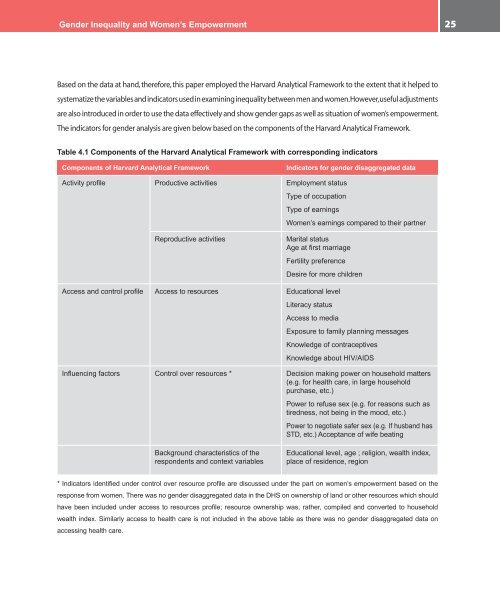Gender Inequality and Women's Empowerment - UNFPA Ethiopia
Gender Inequality and Women's Empowerment - UNFPA Ethiopia
Gender Inequality and Women's Empowerment - UNFPA Ethiopia
Create successful ePaper yourself
Turn your PDF publications into a flip-book with our unique Google optimized e-Paper software.
<strong>Gender</strong> <strong>Inequality</strong> <strong>and</strong> Women’s <strong>Empowerment</strong> 25<br />
Based on the data at h<strong>and</strong>, therefore, this paper employed the Harvard Analytical Framework to the extent that it helped to<br />
systematize the variables <strong>and</strong> indicators used in examining inequality between men <strong>and</strong> women. However, useful adjustments<br />
are also introduced in order to use the data effectively <strong>and</strong> show gender gaps as well as situation of women’s empowerment.<br />
The indicators for gender analysis are given below based on the components of the Harvard Analytical Framework.<br />
Table 4.1 Components of the Harvard Analytical Framework with corresponding indicators<br />
Components of Harvard Analytical Framework Indicators for gender disaggregated data<br />
Activity profile Productive activities Employment status<br />
Type of occupation<br />
Type of earnings<br />
Women’s earnings compared to their partner<br />
Reproductive activities Marital status<br />
Age at first marriage<br />
Fertility preference<br />
Desire for more children<br />
Access <strong>and</strong> control profile Access to resources Educational level<br />
Literacy status<br />
Access to media<br />
Exposure to family planning messages<br />
Knowledge of contraceptives<br />
Knowledge about HIV/AIDS<br />
Influencing factors Control over resources * Decision making power on household matters<br />
(e.g. for health care, in large household<br />
purchase, etc.)<br />
Power to refuse sex (e.g. for reasons such as<br />
tiredness, not being in the mood, etc.)<br />
Background characteristics of the<br />
respondents <strong>and</strong> context variables<br />
Power to negotiate safer sex (e.g. If husb<strong>and</strong> has<br />
STD, etc.) Acceptance of wife beating<br />
Educational level, age ; religion, wealth index,<br />
place of residence, region<br />
* Indicators identified under control over resource profile are discussed under the part on women’s empowerment based on the<br />
response from women. There was no gender disaggregated data in the DHS on ownership of l<strong>and</strong> or other resources which should<br />
have been included under access to resources profile; resource ownership was, rather, compiled <strong>and</strong> converted to household<br />
wealth index. Similarly access to health care is not included in the above table as there was no gender disaggregated data on<br />
accessing health care.


